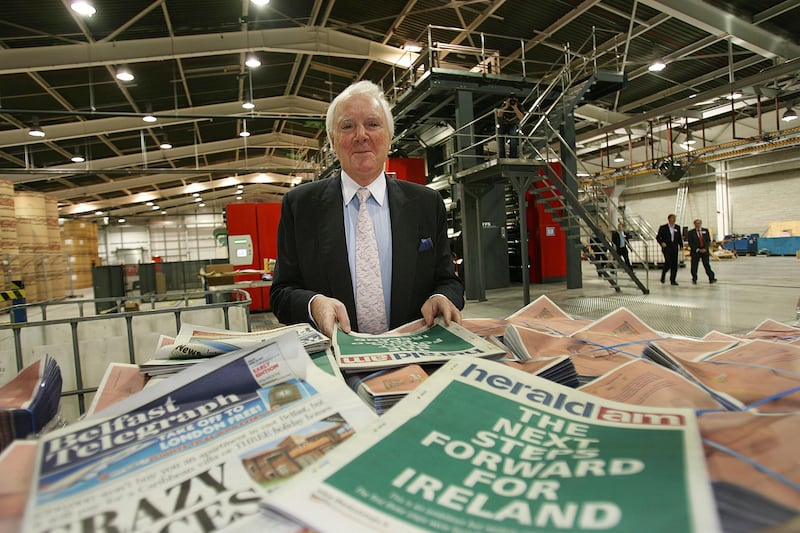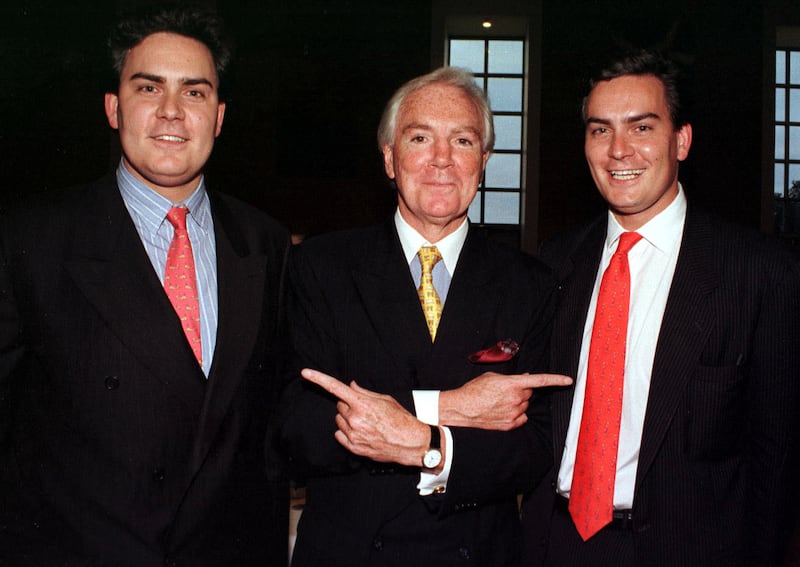Tony O’Reilly, who died on Saturday, became a marketing genius when he put a gold wrapper on a slab of old Ireland, creating the Kerrygold brand that still glitters on the shelves of the world’s supermarkets. This seems apt: O’Reilly was Ireland’s most iconic capitalist, but he ultimately did more to wrap it in a golden sheen of wealth than to create an ideal of sustainable prosperity.
Keeping things under wraps was an impulse he developed early. When he was a teenager, O’Reilly discovered that he was not, as he had always believed, an only child. In his last year at Belvedere College, in Dublin, some of the Jesuit priests who taught him took him aside. They told him that his parents were not married to each other and that his father had another wife and other children – the three half-sisters and one half-brother whom he had never met.
The Jesuits may have told him all of this because they wanted to spare him the shock of later revelations, or they may have been concerned that O’Reilly might be considering the idea of entering the priesthood. An “illegitimate” child, which is how he was stamped in Irish law, could not be a priest.
It was not until 1987 that the legal concept of illegitimacy was removed from the law. Well past the age of 50, O’Reilly, as well as being the richest man in Ireland, was also secretly a second-class Irishman.
The ‘Cable Cowboy’: The US billionaire who made Ireland his home-from-home
‘Tony O’Reilly should have been president of Ireland’: Jeffrey Archer on life, books and his God-given gift
Tony O’Reilly’s lost Dublin town house has a new owner: his godson
Red Flag Consulting sold with expected €33m payout to founder Karl Brophy
It’s hard to avoid the belief that something of his origins must have been present in what O’Reilly became. It may be there in the obsessive hunger for success that was evident in the career of a man who could not be content with being one of the highest-paid chief executives in United States but also tried to build a private industrial empire and to pursue the dream of being a global media mogul.
And it may have been there in the overwhelming desire to control news, to have power over image and information. He was able to do this from very early on. In 1963, when O’Reilly was already famous as rugby star and as the dashing young head of Bord Bainne, his black Mercedes hit a cyclist in Co Kilkenny. His father was able to arrange to have the incident kept quiet, and no newspaper reported O’Reilly’s involvement in the incident.
This is perhaps why he was, in the end, a failure as a media owner. His interest in newspapers was primarily in the prestige and power he could get from owning them. The Sunday Independent under his ownership once devoted an eight-page colour supplement to him with the modest heading “A man for all continents” and no fewer than 17 photographs of the proprietor: Tony O’Reilly with Henry Kissinger, Tony O’Reilly with Margaret Thatcher, Tony O’Reilly with Valéry Giscard d’Estaing; Tony O’Reilly with Robert Mugabe; Tony O’Reilly stepping off his corporate jet; Tony O’Reilly with his beautiful first wife and six beautiful children.

Or rather not “Tony”. He was known as Tony everywhere but in his own newspapers, where he was always referred to as “Dr AJF O’Reilly” – until, that is, he swaggered in his English title and became “Sir Anthony O’Reilly” to every editor and subeditor in his empire.
In March 1987, O’Reilly handed over a piece of England to Margaret Thatcher. Having bought Cape Cornwall, a mile of English coastline, he presented it to the then prime minister at a public ceremony. It was a bizarre act of ingratiation. The rugby writer Terry Maclean, covering the Lions rugby tour of New Zealand in 1959, noted O’Reilly’s attitude to those English members of the side who came from upper-class backgrounds. It was, he wrote, “a strange regard almost amounting to envy for those fortunate folk who move through the world with a lordly calm based upon a secure place in the scheme of things”.
His hunger for a secure place in the scheme of things may have driven O’Reilly, but it was also, in the end, what made him not just the great hero of indigenous capitalism but also the embodiment of its limitations. His notion of success was retro. It was lordly and Anglo: flashing his knighthood, buying the London Independent because, as he told Andrew Marr, “it was simply nice to be able to go through the door of 10 Downing Street and be accepted there”, cosplaying the life of an Ascendancy landlord at Castlemartin, acquiring the deeply English Wedgwood brand. Was this Anglophilia the ultimate golden wrapper on the painful Irish past?

This retro mindset (oddly paralleled in the mentality of the man who might be seen as O’Reilly’s equivalent in Irish politics, Charles Haughey) explains at least in part the great absence in O’Reilly’s career as the nation’s premier capitalist: innovation. His media empire was notoriously slow to adapt to the digital revolution. His failed attempt to become an oil baron, sinking much of his (and other people’s) money into holes on the Atlantic seabed in the hope of striking a great gusher, was an attempt to emulate early 20th-century wildcat fortune hunters. The brands he tried (nobly) to revive, Waterford Crystal and Wedgwood, traded on dying notions of domestic gentility. Ironically, even the most controversial episode in O’Reilly’s career in Ireland – payments by one of his companies to the Fianna Fáil minister Ray Burke – was connected to control of a technology, MMDS broadcasting, that was already redundant.
There is something emblematic in all of this. Too much of the innovation in the Irish economy has been outsourced to US multinational corporations. There are brilliant entrepreneurs in Ireland, but very few of them have managed to build sustainable large-scale companies from new ideas and products. Think of a comparable country like Denmark and the indigenous brands it has developed, from Lego to Ozempic, from Ecco to Velux: how many Irish brands have managed a similar trajectory? In the Irish capitalism that O’Reilly embodied, all that was golden did not keep its glitter for very long.













